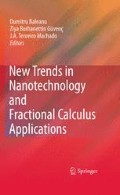Abstract
This chapter is dedicated to presenting some aspects of the so-called Ordinary and/or Partial Fractional Differential Equations. During last 20 years the main underground reason that explain the interest of the applied researchers in the fractional models have been the known close link that exists between such kind of models and the so-called “Jump” stochastic models, such as the CTRW (Continuous Time Random Walk). During the second half of the twentieth century (until the 1990s), the CTRW method was practically the main tool available to describe subdiffusive and/or superdiffusive phenomena associated with Complex Systems for the researches that work in applied fields. The fractional operators are non-local, while the ordinary derivative is a local operator, and on the other hand, the dynamics of many anomalous processes depend of certain memory of its own dynamics. Therefore, the fractional models linear and/or non-linear look as a good alternative to the ordinary models. Note that fractional operators also provide an alternative method to the classical models including dilate terms. The main of this chapter is dedicated to do a first approach to show how introduce Fractional Models only under a deterministic basement. We will considerate Fractional Dynamics Systems with application to study anomalous growing of populations, and on the other hand, the Fractional Diffusive Equation.
Access this chapter
Tax calculation will be finalised at checkout
Purchases are for personal use only
Notes
- 1.
For colors, see online version.
- 2.
For colors, see online version.
References
Bonilla B, Kilbas AA, Trujillo JJ (2003) Cálculo Fraccionario y Ecuaciones Diferenciales Fraccionarias. Madrid, Uned
Gnedenko BV, Kolmogorov AN (1949; 1954) Limit distributions for sums of independent random variables. Addison-Wesley, Massachusetts
Kilbas AA, Srivastava HM, Trujillo JJ (2006) Theory and applications of fractional differential equations. Elsevier, Amsterdam
Kilbas AA, Trujillo JJ (2001) Differential equations of fractional order: methods, results and problems I. Appl Anal 781–2):157–192
Kilbas AA, Trujillo JJ (2002) Differential equations of fractional order: methods, results and problems II. Appl Anal 81(2):435–493
McBride AC (1979) Fractional calculus and integral transforms of generalized functions. Ed. Pitman, London, Adv Publ Program
Metzler R, Klafter J (2000) The random walk’s guide to anomalous diffusion: a fractional dynamics approach. Phys Rep 339(1):1–77
Montroll EW, Weiss GH (1965) Random walk on lattices II. J Math Phys 6:167–181
O’Shaughnessy L (1918) Problem # 433. Amer Math Month 25:172–173
Post EL (1919) Discussion of the solution of Dˆ1/2y=y/x, problem # 433. Amer Math Month 26:37–39
Samko SG, Kilbas AA, Marichev OI (1993) Fractional integrals and derivatives: theory and applications. Gordon and Breach Science Publishers, Switzerland
Sneddon, I. N. (1966) Mixed boundary value problems in potential theory. Amsterdam, North-Holland Publ.
Zaslavsky GM, Stanislavsky AA, Edelman M (2006) Chaotic and pseudochaotic attractors of perturbed fractional oscillator. Chaos 16:013102
Acknowledgements
The authors express their gratitude to MININN of Spain Government (MTM2004-00327), and to the Scholarship FPU of M. Velasco, call order 19843/2007 of 25 of October.
Author information
Authors and Affiliations
Corresponding author
Editor information
Editors and Affiliations
Rights and permissions
Copyright information
© 2010 Springer Science+Business Media B.V.
About this chapter
Cite this chapter
Rivero, M., Trujillo, J.J., Velasco, M.P. (2010). On Deterministic Fractional Models. In: Baleanu, D., Guvenc, Z., Machado, J. (eds) New Trends in Nanotechnology and Fractional Calculus Applications. Springer, Dordrecht. https://doi.org/10.1007/978-90-481-3293-5_10
Download citation
DOI: https://doi.org/10.1007/978-90-481-3293-5_10
Published:
Publisher Name: Springer, Dordrecht
Print ISBN: 978-90-481-3292-8
Online ISBN: 978-90-481-3293-5
eBook Packages: EngineeringEngineering (R0)

